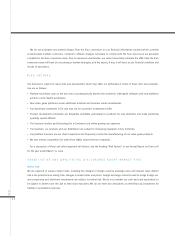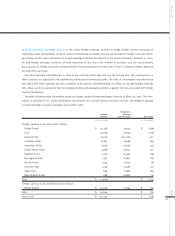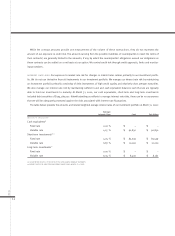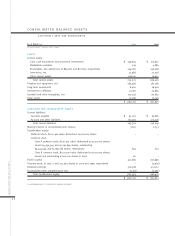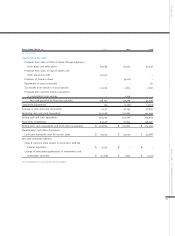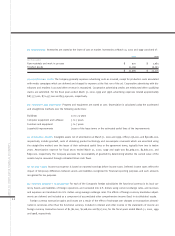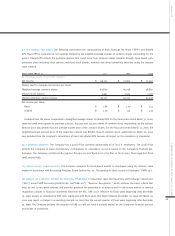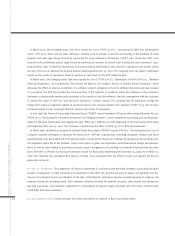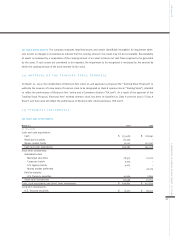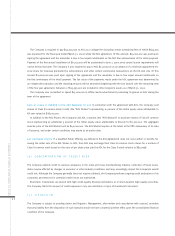Electronic Arts 2000 Annual Report Download - page 44
Download and view the complete annual report
Please find page 44 of the 2000 Electronic Arts annual report below. You can navigate through the pages in the report by either clicking on the pages listed below, or by using the keyword search tool below to find specific information within the annual report.
(1) SUMMARY OF SIGNIFICANT ACCOUNTING POLICIES
CONSOLIDATION The accompanying consolidated financial statements include the accounts of Electronic Arts Inc. and its wholly-
owned and majority-owned subsidiaries (the “Company”). All significant intercompany balances and transactions have been
eliminated in consolidation.
Asummary of the significant accounting policies applied in the preparation of the accompanying consolidated financial
statements of the Company follows:
(A) FISCAL YEAR The Company’s fiscal year is reported on a 52/53-week period that ends on the Saturday nearest to March 31
in each year. The results of operations for fiscal 2000, 1999 and 1998 contain 52 weeks. For clarity of presentation herein, all
fiscal periods are treated as ending on a calendar month end.
(B) REVENUE RECOGNITION The Company’s revenue recognition policies are in compliance with American Institute of Certified
Public Accountants Statement of Position (“SOP”) 97-2,
“Software Revenue Recognition”,
and SOP 98-4,
“Deferral of the
Effective Date of a Provision of SOP 97-2”,
which provide guidance on generally accepted accounting principles for recognizing
revenue on software transactions. SOP 97-2 requires that revenue recognized from software arrangements be allocated to each
element of the arrangement based on the relative fair values of the elements. The Company has adopted the provisions of
these SOPs as of April 1, 1998. The adoption has, in certain circumstances, resulted in the deferral of certain revenues associ-
ated with the Company’s sales promotions and products with multiple deliverable elements. Neither the changes in certain
business practices nor the deferral of certain revenues have resulted in a material impact on the Company’s operating results,
financial position or cash flows for the fiscal year ended March 31, 2000. Total deferred revenue at March 31, 2000 and 1999
was $1,847,000, and $8,206,000, respectively.
In December 1998, the Accounting Standards Executive Committee of the AICPA issued SOP 98-9,
“Software Revenue
Recognition, with Respect to Certain Arrangements,”
which required recognition of revenue using the “residual method” in a
multiple element arrangement when fair value does not exist for one or more of the undelivered elements in the arrangement.
SOP 98-9 is effective for transactions entered into after March 15, 1999. Under the “residual method”, the total fair value of the
undelivered elements is deferred and subsequently recognized in accordance with SOP 97-2. The adoption of SOP 98-9 in fiscal
year 2000 did not have a material change in the accounting for revenues for the Company.
Product Sales: The Company recognizes revenue upon shipment of its packaged goods products based on “FOB Shipping”
terms. Under FOB Shipping terms, title and risk of loss are transferred when the products are delivered to the customer. In
order to recognize revenue, the Company must not have any continuing obligations and it must also be probable that the
Company will collect the accounts receivable. Subject to certain limitations, the Company permits customers to obtain
exchanges within certain specified periods and provides price protection on certain unsold merchandise. Revenue is recognized
net of an allowance for returns and price protection.
Online Subscription Revenues:
Online subscription revenues are derived principally from subscription revenues collected from
customers for online play, who are only contractually obligated for pay on a month-to-month basis. Prepaid monthly subscrip-
tion revenues, including revenues collected from credit card sales as well as sales of
Gametime
subscription cards, are deferred
and subsequently recognized ratably over the period for which the hosting services are provided.
NOTES TO CONSOLIDATED FINANCIAL STATEMENTS
42
NOTES TO CONSOLIDATED FINANCIAL STATEMENTS
March 31, 2000, 1999 and 1998
ELECTRONIC ARTS AND SUBSIDIARIES


